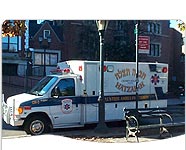 |
 
Allergic Reaction
Topic Overview
Allergies are an overreaction of the immune system. The immune system normally protects the body from viruses and bacteria by producing antibodies to fight them. In an allergic reaction, the immune system starts fighting essentially harmless substances like dust mites, pollen, or a medication as though these substances were trying to attack the body. This overreaction causes problems that affect the skin, nose, lungs, digestive organs, and blood vessels.
Allergic reactions may not occur the first time you are exposed to an allergy-producing substance (allergen). For example, the first time you are stung by a bee, your body's response may be only pain and redness from the sting. With subsequent bee stings, allergic symptoms, such as hives or difficulty breathing, may occur. This is caused by the response of the immune system.
Most people will have some problem with allergies or allergic reactions at some point in their lives. Allergic reactions can range from mild and annoying to sudden and life-threatening. Most allergic reactions are mild, and home treatment can relieve many of the symptoms. An allergic reaction is more serious when:
• Severe allergic reaction (anaphylaxis) occurs. This is not common but can be life-threatening and requires emergency care. Symptoms may include:
o Shock.
o Swelling of the lips, tongue, ears, eyelids, palms of the hands, soles of the feet, and mucous membranes (angioedema ).
o Coughing, wheezing, difficulty breathing, or feeling of fullness in the mouth or throat.
o Lightheadedness and confusion.
o Nausea, diarrhea, and stomach cramps.
o Hives and reddening of the skin. These symptoms often occur with other symptoms of a severe reaction.
• Allergies cause other problems.
• Home treatment doesn't help.
Seasonal allergies show up at the same time of the year every year and are caused by exposure to pollens from trees, grasses, or weeds. Hay fever is the most common seasonal allergy.
Perennial allergies occur for more than 9 months out of the year. Between 20 and 40 million people in the United States are affected by perennial allergies.
Year-round symptoms (chronic allergies) are most likely to occur from exposure to animal dander, house dust, or mold.
Of the many types of allergies, some of the more common ones are:
• Respiratory allergies.
• Skin allergies.
• Allergies to cosmetics, such as artificial nails, hair extensions, and henna tattoos.
• Allergies to medications.
• Allergies to food.
• Allergies to insect venom.
• Allergies to animals.
• Allergies to natural rubber (latex).
• Occupational allergies.
Allergies often occur along with other diseases, such as asthma, ear infections, sinusitis, and sleep apnea. For more information, see the topic Allergic Rhinitis.
If you think you need emergency care, call 911 or other emergency services immediately. If you are concerned about your symptoms, call your health professional.
Author: Sydney Youngerman-Cole, RN, BSN, RNC
Last Updated August 22, 2003
Medical Review: William M. Green, MD - Emergency Medicine
This information is not intended to replace the advice of a doctor. Healthwise disclaims any liability for the decisions you make based on this information. For more information, click here.
© 1995-2004, Healthwise, Incorporated, P.O. Box 1989, Boise, ID 83701. ALL RIGHTS RESERVED.
Back to Safety Tips Index
|









